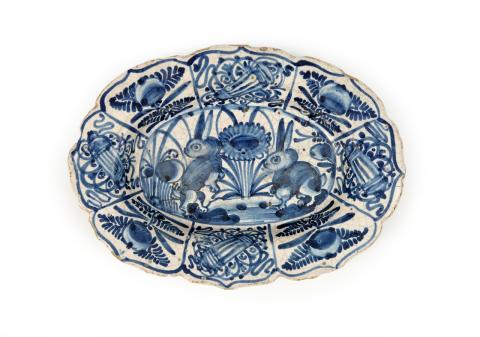Travessa
ELYPTIC TRAY OR DEEP SAUCER
Portuguese faience
Lisbon, 1625-1650
Dim.: 21,0 x 15,5 cm
Travessa elíptica ou covilhete
Faiança portuguesa
Lisboa, 1625-1650
Dim.: 21,0 x 15,5 cm
A small sized, deep, and scalloped tin-glazed tray of painted cobalt-blue decoration, resting on a raised oval foot. The central elliptic section, featuring a composition with two rabbits resting on rock outcrops by a riverbank, and centred by an exuberant flowering bush, is delimited by peripheral plain frieze. Completing the scene, depictions of wild peaches, a motif imported from symbolic Chinese ornamentation, often present in porcelain objects.
Extending down to the well, the elegantly scalloped lip is sectioned into eight cartouches, terminating in curly brackets, and decorated with peach tree branches alternating with ribbon tied painting scrolls, a type of ornamentation that is common in Chinese Kraak porcelain production. On the underside, a sequence of four sinusoidal motifs, centrally placed within equal number of segments, delimited by peripheral bracket shaped filleting.
This small tray clearly illustrates the creative impact of Chinese porcelain on 17th century Portuguese faience production. Although this cultural transfer deprived the various decorative elements of their primary symbolic meaning, the central bush of eccentric flower placed between the two facing rabbits - likely a male and female pair - as if alluding to a Tree of Life, has its origins in an ancestral iconography of creation and fertility, that is widespread in Eastern culture. Portuguese 17th century faience did often adopt this motif (Fig. 1) , that is also known from Chinese and Indian textiles and tiled altar fronts.
The two hares, or rabbits, are featured squatting down. One raises its fore legs while turning its head backwards on the lookout for predators, a sentinel pose that is known on other Portuguese faience objects (Fig. 2). This element is also consequence of the potter’s assimilation of imagery that inhabits Chinese porcelain wares, such as the Kendi at the Topkapi Saray Museum, in Istanbul (Fig. 3), or the pictorial mark on the underside of a plate (Fig. 4) as well as other objects produced during Emperors Jiaqing (1522-1566) and Longqing (1567-1572) reigns.
Various legends have been associated to this animal species as the companion of the Moon Goddess Chang É. In Chinese mythology it is believed that the rabbit grinds the ingredients for preparing the elixir of long life , and Chinese poets often praised the jade rabbit (white rabbit) that eventually became the symbol of the moon.
Similarly, the centrally placed peach trees and their fruits alluded, in their origin, to love and immortality for those who ingested them. This imagery is repeated on the lip sections, alternating with painting scrolls, the badge of Chinese scholars, which are in this instance misrepresented by the Portuguese potter who transformed their wrapping ribbons into “aranhões”, large spider like decorative elements characteristic of 17th century Portuguese faience iconography.
Pequena travessa oval de covo acentuado e aba recortada, coberta de esmalte estanífero branco, com decoração pintada a azul-cobalto. No tardoz, frete recuado e oval.
O fundo está definido por filete elíptico preenchido por paisagem exótica onde se destaca a representação de dois coelhos afrontados sobre rochedos, nas margens de área fluvial e centrados por arbusto de exuberante flor. Completa o quadro vegetação de pêssegos silvestres, de grande simbolismo e muito utilizados na decoração da porcelana chinesa.
A aba que se estende pelo covo é recortada, delimitando oito reservas que terminam em chavetas acompanhando o bordo. Nelas, alternam ramo de pêssego e rolo de pintura envolto em cordões, na distribuição típica do período Krack.
No tardoz, apontamentos pintados em forma sinusoidal, centrados em quatro reservas, que estão delimitadas perifericamente por chavetas.
Trata-se de mais um excelente exemplo de contaminação da porcelana chinesa na faiança portuguesa do seculo XVII. Embora ausente de qualquer tipo de simbolismo, o arbusto central com excêntrica flor entre os dois coelhos afrontados - supostamente um casal – teve a sua origem numa representação ancestral alegórica à criação e à fertilidade, muti comum na cultura chinesa. De igual forma, os pessegueiros com os seus frutos, constituíam símbolos de imortalidade para quem os ingere. Por sua vez a aba, foi decorada a partir dos rolos de pintura, emblema dos letrados chineses e dos ramos de pêssegos, associados ao amor.
- Arte Portuguesa e Europeia
- Azulejos e Faianças

